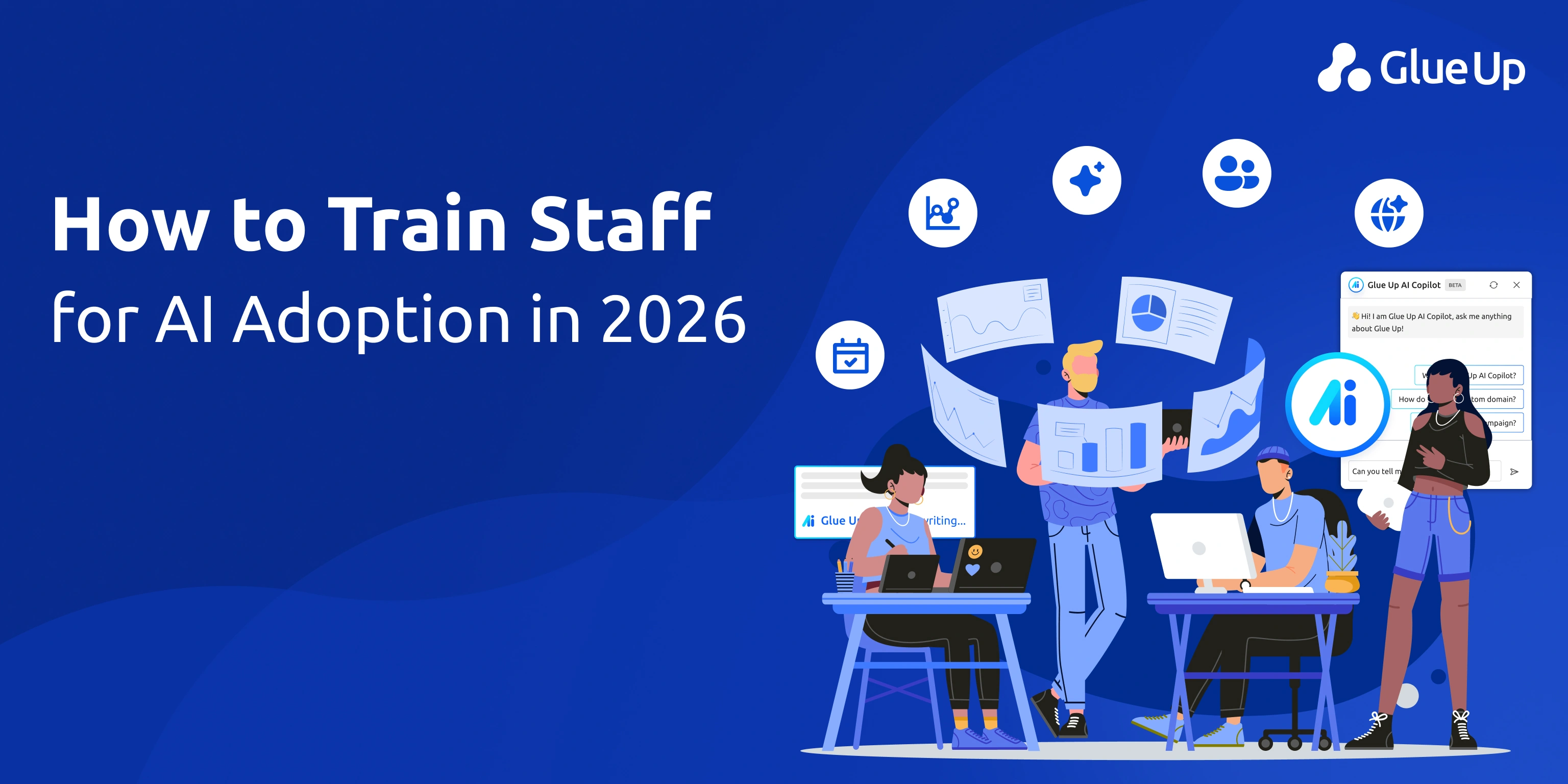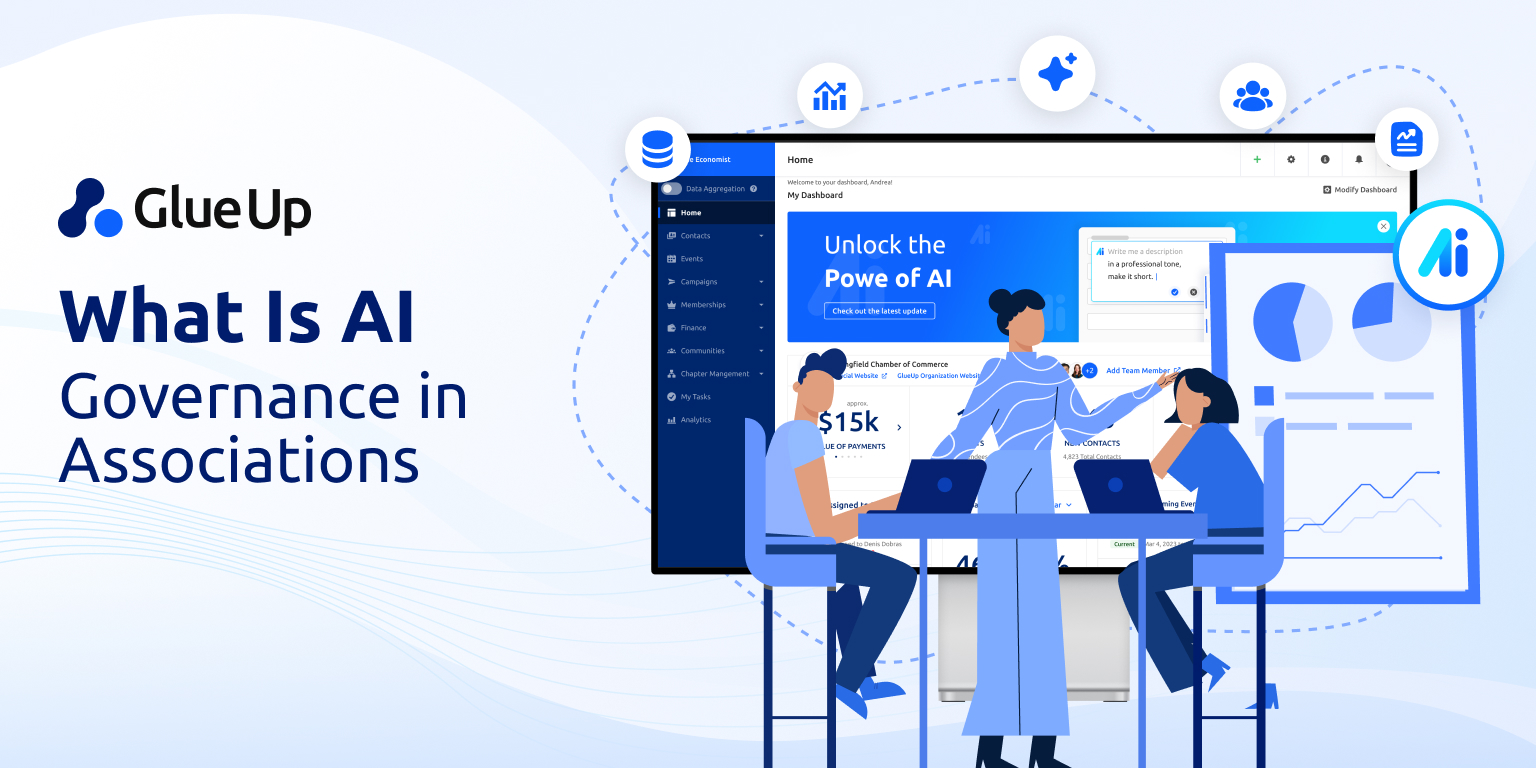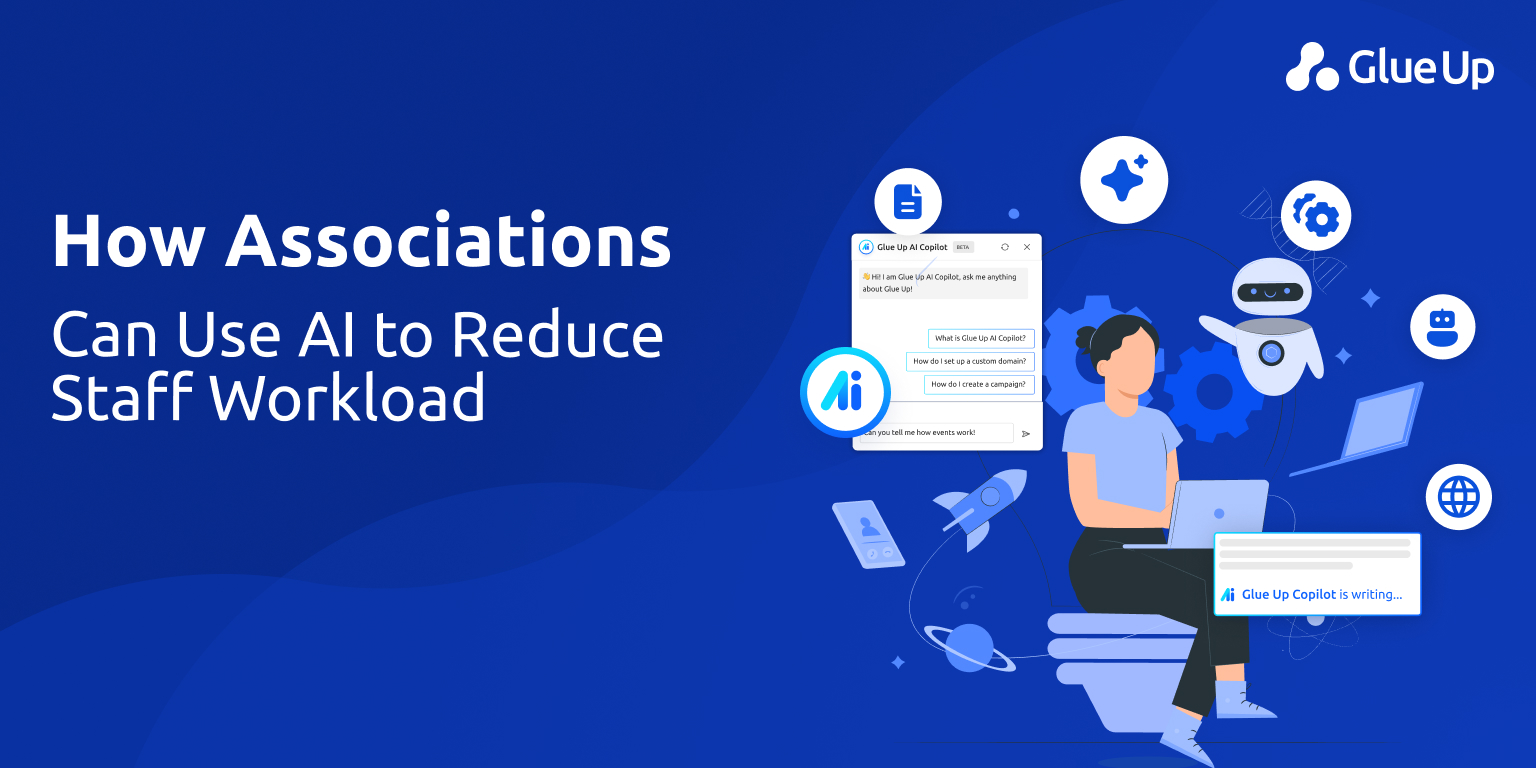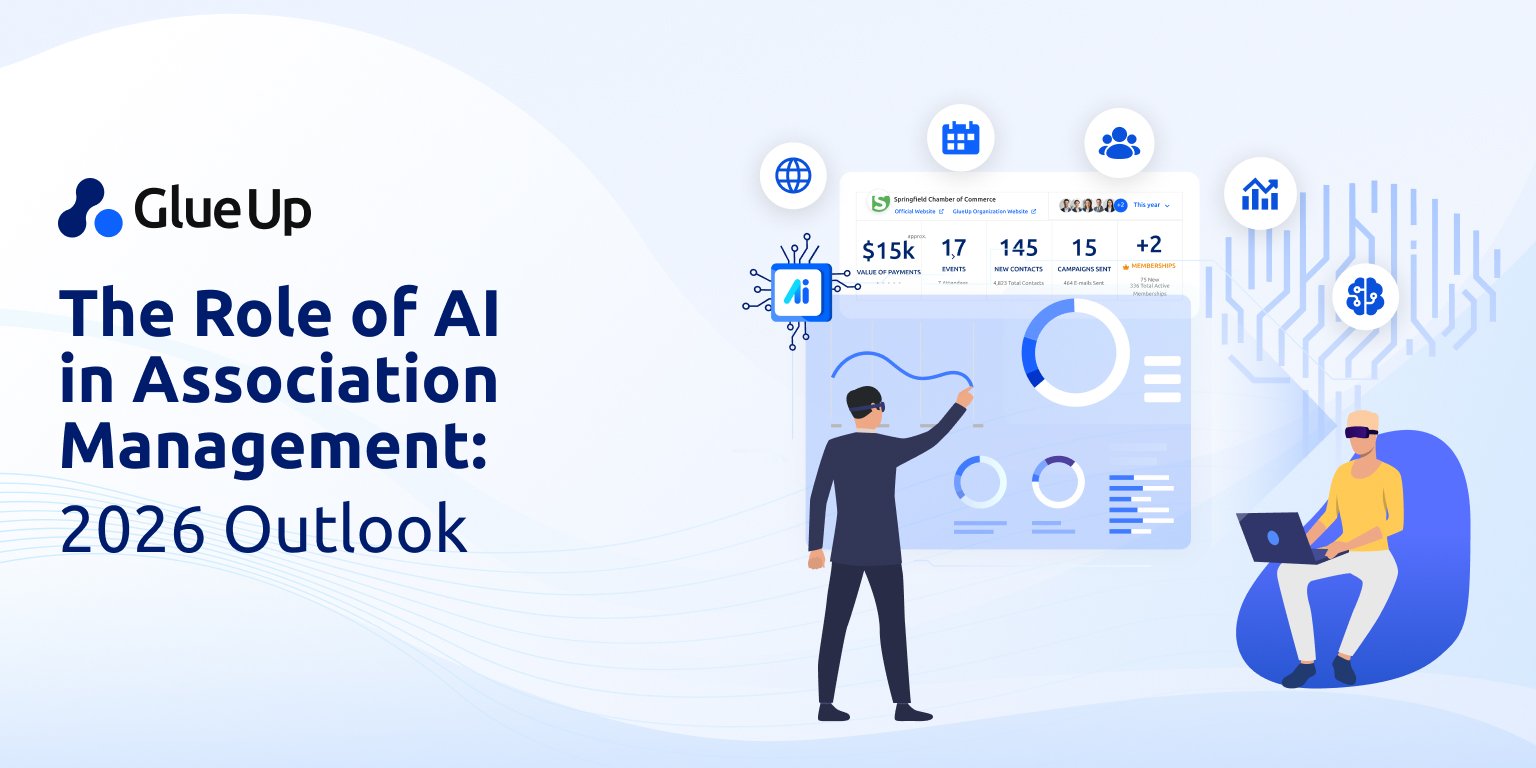
AI training for staff isn’t about teaching code. It’s about changing how people think, make decisions, and work together. For associations built on established systems and habits, that shift starts with culture, not technology.
According to Association Now, organizations that invest in digital confidence see significantly higher adoption rates because their teams understand how AI fits into everyday workflows. That awareness drives better engagement, faster automation, and measurable performance gains.
In this post, we’ll explore how to train staff for AI adoption in 2026. Looking to accelerate the transition? Switch to Glue Up’s all-in-one AI-powered association management software, built to streamline operations, increase visibility, and drive engagement across every department.
Key Modules Include:
- Membership Management Software: Automate renewals, workflows, and member data tracking.
- Event Management Software: Plan, promote, and measure in-person, virtual, or hybrid events effortlessly.
- Email Marketing Automation Software: Personalize campaigns, segment audiences, and boost engagement at scale.
- Finance Management Software: Simplify billing, reporting, and revenue tracking with complete accuracy.
The Real Barrier Isn’t Technology, It’s Readiness
For most associations, the real challenge of AI adoption is not the technology itself but organizational readiness. AI succeeds only when people know how to interpret its outputs, trust its logic, and integrate its insights into daily decisions.
AI readiness is a leadership issue. It demands a culture where staff are equipped to apply critical thinking, adapt workflows, and align automation with measurable outcomes. As Betterworks notes, autonomy drives performance only when teams are empowered with clear frameworks and consistent feedback loops. The same applies to AI-driven operations.
In many associations, institutional knowledge sits in small teams that operate on intuition rather than systems. Without structured training and governance, that expertise doesn’t scale. According to Invenia Tech, organizations that fail to establish disciplined oversight frameworks often face misalignment between technology goals and operational execution.
True readiness starts when leadership defines where AI creates tangible value, such as forecasting event attendance, improving member segmentation, or automating renewals, and embeds those objectives into accountability structures. When governance aligns with skill-building, AI moves from potential to performance.
Building an AI Training Framework That Drives Adoption
AI adoption starts with a clear framework, not scattered learning sessions. For associations, training must be structured, role-based, and continuous—an investment in organizational intelligence rather than a one-time exercise.
Effective AI training for staff begins with mapping where automation intersects with daily responsibilities. Frontline employees may need AI literacy programs focused on task automation and member communication, while senior leaders benefit from AI governance and decision-making workshops that connect outcomes to strategy.
An AWS Thought Leadership Post highlights that most AI training fails because it focuses on tools instead of workflows. When staff understand how AI applies to renewals, event analytics, or financial forecasting, adoption accelerates naturally. Context, not code, drives capability.
To build AI readiness training that lasts, associations should:
Start with Baseline Assessments
Before jumping into training, take stock of where your teams stand. Every department has different strengths. Your membership staff might excel at engagement but feel unsure about automation tools. Your event team could be data-driven but unfamiliar with predictive analytics. Running baseline assessments helps you understand these gaps early, so training can be designed around real needs instead of generic tutorials. It’s about meeting people where they are and building confidence from there.
Create Department-Specific Pathways
AI adoption works best when training connects directly to day-to-day responsibilities. Marketing teams can learn how to use AI to segment audiences or generate personalized campaigns. Finance teams can practice forecasting revenue and automating invoice cycles. Membership managers can focus on predictive retention tools or AI-driven onboarding flows. The more relevant the learning path, the faster your staff sees results—and that’s what builds momentum across the organization.
Incentivize Experimentation
People adopt what they’re encouraged to try. Reward teams that test AI in their daily work, whether it’s automating renewal reminders, analyzing event feedback, or generating reports. Highlight early wins in internal updates or team meetings so others see what’s possible. When leaders celebrate experimentation instead of perfection, staff feel safe exploring new workflows. That’s how adoption becomes part of the culture, not just a temporary initiative.
Measure Adoption Metrics
AI training isn’t successful until it changes behavior. Track specific outcomes like time saved on manual tasks, faster reporting turnaround, or improved campaign conversions. Review these results regularly with your leadership team to see where progress is happening—and where more support is needed. Measurable adoption makes the value of training visible, helping you justify further investment and keep staff motivated to keep learning.
This approach builds confidence and clarity. Teams stop fearing replacement and start recognizing AI as an amplifier of performance. Once staff see AI as a partner, adoption no longer feels like disruption—it becomes progress.
The Role of Leadership in Sustaining AI Transformation
AI adoption succeeds or fails based on leadership clarity. Tools can automate workflows, but it takes executive alignment to sustain transformation. When leadership treats AI as a strategic enabler rather than a technology project, staff follow with greater purpose and accountability.
Leaders set the tone for AI governance in associations. They decide whether automation reinforces transparency, accuracy, and consistency across operations, or becomes another layer of complexity. According to The CEO Project, strong governance doesn’t reduce autonomy; it strengthens it by giving teams structure to innovate responsibly. That same principle defines successful AI management.
Sustaining transformation requires AI leadership readiness. Executives should model adaptability by using AI-generated insights in board reporting, forecasting, and member engagement reviews. This signals that AI is part of daily decision-making, not a parallel initiative.
Associations that pair vision with structure see the greatest impact. When governance frameworks define access, accountability, and performance standards, AI becomes integrated into culture. Teams learn that using data-driven tools isn’t a compliance task—it’s a leadership expectation.
The outcome is stability. AI stops being a future concept and becomes part of how the organization operates, measures success, and delivers value to members every day.
How Glue Up Simplifies AI Adoption for Associations
AI adoption is only as strong as the support behind it. Even the most advanced technology fails when staff don’t know where to start. Glue Up’s AI-powered association management software was designed with that challenge in mind. Every feature, module, and training touchpoint helps associations move from learning to application faster and with less disruption.
The platform integrates AI training for staff directly into the user experience. Guided onboarding, tutorials, and contextual learning prompts help teams understand not just what to do, but why it matters. This minimizes hesitation and builds confidence across departments from day one.
Associations that partner with Glue Up benefit from a complete adoption ecosystem:
- Interactive Demos and Personalized Walkthroughs: Every client begins with scenario-based demos that map AI use cases, such as automating renewals, analyzing engagement, or generating event insights, to their existing workflows.
- Learning Management System (LMS): Training resources and video guides with certificates turn onboarding into a structured learning path, allowing new staff to gain practical AI literacy without external trainers.
- Webinars and Best Practice Sessions: Our product specialists and customer success managers regularly host live sessions that help users master updates, explore new automation capabilities, and share adoption insights from other associations.
- 24/7 Support and Dedicated Account Guidance: Real-time chat and account-level support ensure teams never face adoption barriers alone. Each organization receives a guided roadmap for full implementation and skill development.
The result is seamless adoption. Associations don’t need external consultants or year-long training programs. Staff learn, apply, and measure impact within a unified system built for association workflows.
Our goal is to reduce the friction that traditionally slows digital transformation. Training becomes continuous, confidence compounds with every workflow, and leaders gain visibility into how AI is driving measurable outcomes across membership, events, and operations.
So, if you’re looking to upskill your team for 2026 while centralizing your membership workflows into an all-in-one platform powered AI, book a demo today.
Frequently Asked Questions
Why is AI training essential for association staff?
Because AI tools are only as effective as the people using them. Training equips teams to understand, trust, and apply AI insights, ensuring better member engagement, faster workflows, and stronger governance alignment.
How can small associations afford structured AI training?
Start small with in-platform learning, built-in tutorials, and targeted sessions. Solutions like Glue Up include guided onboarding, LMS resources, and customer webinars that reduce the need for external consultants.
What KPIs can measure AI adoption success?
Common KPIs include task completion time, automation rate, campaign performance, and member retention improvements. Each metric connects directly to operational efficiency and member value delivery.
How long does effective AI training take?
Initial onboarding typically spans four to six weeks, followed by ongoing reinforcement through webinars and real-world applications. Continuous learning is key to sustained readiness.
How does Glue Up support AI training for associations?
Glue Up’s AI-powered platform integrates guided demos, on-demand learning, and personalized onboarding to help associations adopt automation seamlessly while tracking progress across departments.
Quick Reads
- How to Build a Revenue Engine with Association Management Software
- Add-On Cart for Member Retention & Growth
- Simplify Multi-Currency Payment Posting for Community Chapters With Glue Up + Paygage
- AI Automation for Event Registration & Beyond
- Integrating AI into CRM for Membership Growth
- How to Build a Chapter Event Calendar
- What Is All-In-One Association Software?



